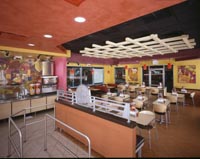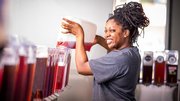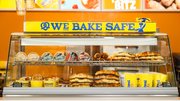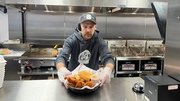Article
El Pollo Loco walks a fine line
Neither fast casual nor QSR, the hybrid provides consumers with speed and quality.

April 16, 2006
Why did the chicken cross the border? To establish a national brand.
At least that's the answer on the lips of El Pollo Loco's management team headed by president and chief executive Stephen Carley.
|
"There are some significant consumer trends that are like winds at our back filling our sails," Carley said. "For one, chicken is the most popular protein consumed. For another, Americans are looking for flavorful, more spicy, more interesting foods. They're looking for more diversity in their menu."
El Pollo Loco (Spanish for crazy chicken) opened 12 new restaurants during 2005, the majority in California. Today, there are 340 locations in California, Arizona, Nevada, Texas and Illinois. For fiscal 2006, the company estimates it will open seven to 10 company stores and between 12 and 16 franchise stores. Four company-owned restaurants and three franchised restaurants opened in the first quarter of this year.
"We're looking at markets on the East Coast and in the Southeast," Carley said. "We know that a key to our success is a tremendous affinity among Hispanics of Mexican origin, the fastest-growing minority segment in the country. We cook the food in a way that they recognize, respect and revere. It reminds them of Mexico, or how their mother or aunt cooked."
Sold onthat idea are David Peterman and business partner Mitchell Roberts, who recently signed an agreement to open 25 locations throughout New England. The first store is slated to open in July at Foxwoods Resort and Casino in Mashantucket, Conn. Peterman, a native of Southern California, has known of El Pollo Loco since its U.S. entry in 1980.
"I always thought it was a good product with an interesting concept," said Peterman, who, with Roberts, also owns and operates 20 Panera Bread locations in three states.
Signing on with El Pollo Loco was, in part, a matter of Peterman seeing that New England was ready for a differentiated product "with an edge to it."
"We've noted in recent years the change in demographics in the United States, not just ethnically, but a broadening of sophistication with food in general,"Peterman said. "We saw restaurants like Chipotle come to the East Coast with success. So we recognized that New Englanders desired to have different food, food that was healthful and not mainstream, prepared in new and exciting ways. That's what El Pollo Loco brings."
 |
From the execs to the operators, El Pollo Loco associates don't really know if they're QSR or fast casual. The quality of food and speed of services makes them more of a hybrid. |
Peterman and Roberts also were attracted to El Pollo Loco's experienced management team.
"They have a strong leadership team that I believe will continue to direct their brand in a positive, strong way for many years to come," Peterman said
But categorizing the brand is elusive. From the execs to the operators, El Pollo Loco associates don't really know if they're QSR or fast casual.
"When we talk to consumers, we're a hybrid; our food is as good as or better than any fast casual, but our value and convenience is like a QSR," Carley said.
Uniquely El Pollo Loco
Originating in Guasave, Mexico, in 1975, the concept entered the U.S. market with a location in Los Angeles five years later. The company's Mexican pedigree plays in El Pollo Loco's favor with a message of menu authenticity.
"They've taken a part of Mexican cuisine, and they've protected the integrity of the product," said Thomas Costello, restaurant consultant and director of hospitality management at the University of San Francisco. "Coming from Mexico gives the company an authentic feel. But they were smart enough not to take on more items like beef and pork that would have watered down their product. They just took a little slice of the cuisine and remained true to duplicating it."
Staying true to its chicken-derived mainstay wasn't always the case. During the years under Advantica Restaurant Group's ownership until 1999 when American Securities Capital Partners took over, kitchens dabbled with pork, beef and fish. About five years ago, after Carley was on board, a strategy to stick with its chicken core was firmly adopted.
"In the industry's hyper-competitive landscape, we determined that we would be the best in the world at fresh, natural, marinated, flame-grilled chicken," said Carley. "We believe we can do that. I don't believe you can be the best in the world at chicken, pork, beef, fish, lobster and, say, tofu. We came to that conclusion by looking at the key drivers of our business and what our consumers were telling us."
The open-kitchen concept connotes ingredient freshness according to Costello.
"El Pollo Loco's concept is a very user-friendly style of service," Costello said. "Everything is in view. You see the chicken cooking on the broilers, you see them assemble the entrees, you can get your own salsa. At many places, you don't see the food being cooked at all. From an integrity point of view—meaning integrity of concept—everything is in front of the guest, and that puts them a step above other places. It enhances the value in the guests' eyes."
Drive-thru power
-- Thomas Costello University of San Francisco |
Many El Pollo Loco locations use drive-thrus, but the company's "cooked fresh" philosophy makes the window an operational challenge.
"There's a delicate balance between speed of service, accuracy, friendliness and not compromising food quality," Carley said. "Our layout and food production systems are very efficient, which means we can deliver food through the drive-thru at speeds approaching speeds of some of the best folks in QSR."
With its enviable 50-50 lunch and dinner day-part mix , the challenge to operators in 2006 is a program called "Gone in 60 Seconds."
"We want drive-thru customers to spend no more than 60 seconds at the window," Carley said. "That's a fast-food standard. We're not there yet, but that's our goal."
 By the Numbers
By the Numbers









